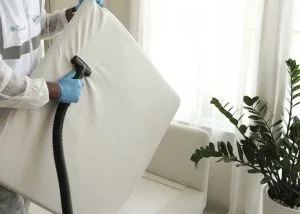Contents
ToggleKey Takeaway:
- Excess rainfall can contribute to a sinking lawn by reducing grass density and weakening grass roots, causing the soil to become compacted and prone to sinking.
- Mowing grass too short can also lead to a sinking lawn, as it weakens the grass root system and reduces its ability to provide support to the soil.
- Thatch build-up on the lawn can contribute to sinking, as it prevents proper water drainage and air circulation, leading to compacted soil and a weaker grass root system.
Introduction
Have you ever walked across your lawn only to feel it give way beneath your steps? It’s a common experience that leaves many homeowners scratching their heads in frustration.
In this article, we’ll unravel the science behind why lawns seem to sink underfoot. We’ll explore everything from soil composition and compaction to moisture levels, shedding light on the factors that contribute to this soft-ground phenomenon.
By understanding the underlying causes, you’ll be better equipped to care for your lawn, ensuring it remains lush, level, and resilient. So let’s journey into the curious world of sinking lawns and find out how to keep them standing firm.
Expert Tips for Lawn Stability
The experience of a lawn sinking underfoot is not only disconcerting but also indicates underlying issues that many homeowners face. By identifying the root causes—be they environmental factors like excessive rainfall and poor drainage, or lawn-care habits such as shallow grass-rooting and over-mowing—you can take targeted steps to address them. Thatch buildup is another culprit that compromises the stability of your lawn, making it susceptible to sinkage.
To enhance the resilience of your lawn, consider the following proactive measures:
- Evaluate Your Drainage: Poor drainage is often a primary cause of lawn sinkage. Make sure the area surrounding your property has adequate drainage systems in place.
- Analyze Soil Type: Different soils have varying levels of compaction and water retention, which can contribute to sinking issues. Knowing your soil type can help you take customized care of your lawn.
- Optimize Water Runoff: Drainage isn’t just about what’s under your lawn; it’s also about how water flows on the surface. Check for slopes or depressions that might collect water, exacerbating the problem.
- Apply Topsoil: A layer of topsoil can help level your lawn and add stability, reducing the chances of it sinking when walked upon.
- Regular Aeration: Soil compaction can lead to sinking. Periodic lawn aeration allows your soil to breathe, enhancing root growth and improving stability. For more tips on what to do after aerating your lawn, check out this guide.
By taking these steps, you’ll be well on your way to maintaining a lawn that doesn’t just look good, but also stands up to foot traffic. Remember, regular maintenance is your best ally in preventing a sinking lawn and ensuring its longevity.
Spotting a Sinking Lawn

Spotting the signs of a sinking lawn early on is crucial for preventing further damage and avoiding expensive repair work. Knowing how to recognize these indicators will arm you with the knowledge you need to take immediate corrective action.
Additionally, understanding the contributing factors can guide you in implementing preventative measures. By staying vigilant and monitoring your lawn for these signs, you can maintain its health and appearance for the long haul.
Signs Your Lawn is Sinking
Recognizing the signs of a sinking lawn is crucial for timely intervention and effective management. Here’s a comprehensive 5-step guide to help you identify a sinking lawn and what could be causing it:
- Spot the Unevenness: Keep an eye out for sunken or lowered patches in your lawn. These could be indicative of soil compaction or subsidence, factors that contribute to a sinking lawn.
- Feel as You Walk: Take a stroll across your lawn and pay attention to any areas that feel soft or spongy underfoot. These could be red flags signaling weakened soil structure or poor drainage.
- Watch for Water Pooling: After a rainfall, examine your lawn for areas where water seems to accumulate rather than drain. This could point to inadequate drainage, which may lead to soil erosion and a sinking lawn over time.
- Assess Grass Health: Take note of any thin or discolored patches of grass. If these can’t be attributed to pests or diseases, they could be signs of underlying issues causing your lawn to sink.
- Conduct a Soil Test: Extract soil samples from different parts of your lawn and analyze their composition. Soil that is overly compacted, clay-rich, or lacking in organic matter may contribute to a sinking lawn.
Beyond these identifying steps, keep in mind that environmental factors like seasonal changes and weather conditions can also affect your lawn’s stability. Regular monitoring and maintenance are key to catching issues before they escalate into bigger problems.
Key Causes of Lawn Sinkage
A sinking lawn can be a frustrating problem, and various factors contribute to this vexing issue. Excessive rainfall is a common culprit, as it can lead to diminished grass density and thereby result in a sinking lawn. Shallow grass roots are another contributing factor; they can fail to provide the necessary support to the lawn’s surface, particularly when it’s walked on frequently.
Overzealous mowing that leaves the grass too short can also weaken its structure and make your lawn more susceptible to sinking. Not to be overlooked, thatch buildup is another key factor, as it hampers proper water drainage and thereby exacerbates the sinking problem.
It’s essential to recognize that this list of contributing factors is not exhaustive. Every lawn is unique, with its own set of conditions such as soil type and drainage patterns that must be considered when addressing sinking issues. Therefore, tailored assessments are crucial for effective solutions.
Why Lawns Sink

Ever wondered why your lawn seems to sink underfoot as you stroll across it? A range of factors contribute to this puzzling but common issue. One of the main culprits is excessive rainfall, which can weaken the grass’s density, thereby diminishing the lawn’s structural integrity.
Another important factor is the depth of your grass roots; shallow roots offer inadequate support, especially when bearing the weight of foot traffic. Incorrect mowing practices can also be to blame: cutting your grass too short can make it less resilient, thereby contributing to a sinking sensation when walked on.
Let’s not forget about thatch build-up, which disrupts proper water drainage and can further exacerbate sinking issues. Understanding these factors can help you diagnose why your lawn might be giving way beneath you, offering the first step toward a long-term solution.
Rainfall’s Impact on Lawn Density
While we often welcome rain for the benefits it provides to our lawns, an excess of it can actually do more harm than good. When rainwater inundates the soil, it leads to poor aeration, starving the grass roots of the much-needed oxygen they require for optimal growth. This not only stunts root development but also weakens the overall density of the grass, making your lawn more susceptible to sinking when walked on.
Compounding the issue, excessive rainfall can also cause soil compaction. The pressure from the infiltrating water causes soil particles to pack tightly together, which further limits the roots’ access to air and vital nutrients. This creates a cycle of poor grass health and reduced density.
But the problems don’t stop there. A continuously wet environment sets the stage for the growth of fungal diseases that can attack both the blades and roots of the grass. These diseases can create patches of dead or weakened grass, further decreasing the lawn’s overall density and stability.
To tackle these issues head-on, a key step is to improve drainage around your property. Efficient drainage systems will help redirect water away from your lawn, mitigating the risk of soil oversaturation and helping maintain a dense, robust lawn that stands up to foot traffic.
For tips on how often to water new grass seed, especially after discussing the impact of rainfall, read this article.
Shallow Roots and Sinking
One of the key factors leading to a sinking lawn is the presence of shallow grass roots. A shallow root system is unable to anchor the grass securely, causing the lawn to sink when subjected to pressure like foot traffic. But what causes these roots to remain near the surface, providing inadequate support?
Several factors contribute to shallow root development. Among them are poor soil quality, nutrient deficiencies, and soil compaction. Complicating matters further, improper watering and frequent mowing at low heights can actively inhibit the roots from penetrating deeper into the soil. As a result, the grass remains poorly anchored, leading to sinking areas that mar the lawn’s appearance and functionality.
The ramifications of a shallow root system extend beyond aesthetic concerns. These weak roots are less capable of drawing essential nutrients and moisture from the soil, compromising the lawn’s overall health. Additionally, a superficial root system leaves the grass vulnerable to environmental stresses like drought or, conversely, excessive rainfall.
So, what can be done to encourage deeper, more supportive root growth? For starters, consider regular lawn aeration to relieve soil compaction. This simple practice opens up the soil, allowing roots to extend more deeply. Also, pay attention to your watering practices; adequate hydration promotes healthy root development, but over-watering can be counterproductive. Lastly, be mindful of your mowing height. Keeping your grass a bit longer can encourage photosynthesis, providing the roots with the energy they need to grow deeper.
To learn how to aerate and overseed your lawn effectively, check out this guide.
Mowing Pitfalls
One common but often overlooked factor that contributes to a sinking lawn is the practice of mowing grass too short. When you cut your grass too close to the soil, you’re not just affecting the lawn’s appearance; you’re also inhibiting its overall health and resilience. Here’s how mowing too short can lead your lawn down a slippery slope.
First, cutting grass too short limits its ability to conduct photosynthesis effectively. This process, crucial for plant growth, relies on sufficient leaf surface to capture sunlight and nutrients. When you mow the grass too low, it struggles to nourish itself, resulting in weaker, thinner growth. This, in turn, makes your lawn more susceptible to the pressures of foot traffic, ultimately causing it to sink.
Secondly, the short mowing height also negatively impacts root development. When the grass is kept too short, it doesn’t have the necessary leaf surface to support a robust root system. Consequently, the roots remain shallow, weakening the lawn’s overall structural integrity and making it more prone to issues like drought and poor water absorption.
The third concern is that of thatch build-up. Mowing too low often results in a thick layer of thatch—dead plant material that accumulates on the soil surface. Excessive thatch can impede air circulation and water infiltration, leading to soil compaction. This, combined with reduced nutrient absorption, creates an environment ripe for disease and pest infestations.
So, how do you counteract the negative effects of mowing too short? Begin by adjusting the height settings on your lawn mower. Aim to cut no more than one-third of the grass blade length at each mowing session.
This height supports healthy regrowth and encourages a deeper, more resilient root system. Another effective practice is regular core aeration, which alleviates soil compaction and boosts water and nutrient absorption.
Lastly, consider leaving some grass clippings on the lawn post-mowing. These clippings decompose to return valuable nutrients to the soil, improving its health and reducing thatch over time.
For more insights on when to start mowing your lawn, read this article.
Thatch Build-up Solutions
Thatch build-up is a major culprit in causing lawns to sink. This layer of organic debris interferes with water drainage and nutrient absorption, weakening the grass and making the lawn more susceptible to sinking when walked on. The problem is exacerbated when the thatch layer becomes a breeding ground for pests and diseases.
To combat this, regular dethatching is crucial. Using specialized tools, you can remove this obstructive layer to improve air circulation and nutrient penetration, thus preventing your lawn from sinking.
Experts like those at Lawn Doctor suggest that a thatch layer exceeding 0.5 inches needs immediate attention to avoid further lawn sinking. So, for a lawn that stays level, keep an eye on thatch build-up and act accordingly.
Quick Fixes for Sinking Lawns

Addressing a sinking lawn? Start by improving drainage to prevent water accumulation and soil compaction. Assess your soil type, as some are more prone to sinking. Enhance stability by adding topsoil and aerating your lawn regularly. These simple steps offer a quick remedy to keep your lawn level and robust.
Check Your Drainage
Ensure a robust lawn by regularly assessing your property’s drainage. Examine the yard’s grading to ensure it slopes away from buildings and prevents water pooling. Clear any clogs in gutters and downspouts to facilitate water flow. For persistent drainage issues, consider installing French drains or catch basins. Proper drainage is vital in preventing your lawn from sinking underfoot.
Understand Your Soil
Understanding your soil type is essential for preventing a sinking lawn.
- Conduct a color and texture test to gauge organic matter and drainage capacity.
- Perform a squeeze test and pH test to further evaluate soil composition.
- Observe water drainage patterns after rain or irrigation; poor drainage may call for soil amendments or drainage systems.
- For a comprehensive analysis, consider professional soil testing. Knowing your soil type allows for targeted lawn care practices, ensuring a resilient and healthy lawn.
5 Steps to Fix Drainage
Improper drainage can make your lawn prone to sinking. To combat this, a comprehensive drainage management strategy is essential. Here are five key steps:
- Check the Slope: Ensure your lawn slopes away from structures to enable natural drainage. If not, regrading may be necessary.
- Extend Downspouts: Attach extensions to gutter downspouts to channel water away from the lawn, preventing water accumulation close to the house.
- Employ Swales and Berms: Utilize swales (shallow ditches) and berms (raised areas) to strategically direct water flow away from problem spots.
- Install French Drains: For chronically wet areas, French drains can collect and divert excess water, reducing soil saturation and lawn sinking.
- Regular Maintenance: Keep gutters and drains free of debris to ensure effective water flow.
According to research from the Journal of Environmental Horticulture, poor grading and soil compaction are key contributors to inadequate lawn drainage.
Topsoil for Stability
Sinking lawns can often be rejuvenated through the strategic addition of topsoil. This simple but effective remedy tackles underlying problems like soil compaction and poor drainage, encouraging healthier grass growth.
To get started, first clear your lawn of debris or obstacles. Then, determine your soil type and choose a compatible topsoil blend. Apply an even layer across the lawn to prevent uneven growth and compaction issues.
Adding topsoil not only revitalizes the nutrient content of your lawn but also improves soil structure. This facilitates better water absorption and air circulation, making your lawn more resilient to sinking. So, if you’re wrestling with a sinking lawn, consider adding a layer of topsoil as a straightforward and effective solution.
Lawn Aeration Tips
One of the most effective ways to combat a sinking lawn is through regular aeration. This process involves perforating the soil to allow water, nutrients, and air to penetrate, resulting in a more resilient and healthier lawn.
Before you begin, mow your lawn and clear any debris. Depending on your lawn’s specific needs, choose between spike, plug, or manual core aerators. For optimal results, aerate when the soil is moist but not waterlogged, and steer clear of extreme weather conditions or heavy foot traffic.
To aerate, simply make evenly spaced holes across your lawn, giving special attention to compacted or poorly drained areas. Afterward, it’s beneficial to leave any soil plugs on the lawn; these will break down naturally and enrich the soil. A light watering and optional fertilization can further boost grass recovery post-aeration.
Remember, different grass types may require specific aeration techniques, so tailor your approach accordingly. By incorporating regular aeration into your lawn care routine, you can lift your sinking lawn back to a level of health and vitality.
Conclusion
In summary, tackling the issue of a sinking lawn is essential for both its aesthetic appeal and long-term stability. Proactive measures like improving drainage, adding topsoil, and regular aeration can not only prevent further sinking but also rejuvenate your lawn. Adopting these best practices will ensure that your outdoor space remains resilient, capable of standing up to regular use and foot traffic. Make these strategies part of your routine lawn care, and you’ll enjoy a lush, level lawn for years to come.
Five Facts
- ✅ Sinking lawns can be caused by heavy foot traffic, vehicular traffic, and excessive rainfall. (Source: Team Research)
- ✅ Compacted soil makes the lawn dense and spongy, making it difficult for grass roots to take hold. (Source: Team Research)
- ✅ Checking the drainage around your property can help alleviate the sinking of your lawn. (Source: Team Research)
- ✅ Aerating the lawn regularly allows air and water to reach the grass roots, preventing compaction. (Source: Team Research)
- ✅ Adding topsoil over the surface can provide a loose layer for grass roots to penetrate and improve drainage. (Source: Team Research)
FAQs
Why does a lawn sink when you walk on it?
There are a few reasons why a lawn may sink when you walk on it. One reason is that when grass is wet, it is more likely to compress, making the lawn denser and causing footprints to sink. Shallow grass roots and mowing the lawn too short can also contribute to sinking. Additionally, if the lawn has a thatch problem, it can impede drainage and make it difficult for new grass blades to take root.
What are the causes of a sinking lawn?
Several factors can cause a sinking lawn, including heavy foot traffic, vehicular traffic, and even rainfall. Compacted soil that becomes dense and spongy makes it difficult for grass roots to take hold, resulting in a sinking lawn. Other causes include poor drainage, low-lying areas, and the presence of clay soil that doesn’t allow proper water absorption.
How can I fix a sinking lawn?
To fix a sinking lawn, you can take several steps. First, check the drainage around your property and ensure that water flows away from your home. Additionally, amending clay soil with organic matter can improve drainage. It’s important to keep the area around your lawn well-drained to prevent waterlogged soil from compacting and causing the lawn to sink. Adding topsoil over the surface, regularly aerating the lawn, and using a high-quality fertilizer can also help relieve compacted soil and promote healthy grass growth.
What are the signs of a sinking lawn?
There are a few signs that indicate a sinking lawn. If certain areas of the lawn appear sunken or depressed, if the surface feels spongy or marshy, or if a hole made with a finger or garden tool remains open, it’s a clear indication that the soil is too loose and prone to sinking. Paying attention to these signs is important to take action and improve the condition of the soil before further damage occurs.
How can I prevent my lawn from sinking when walked on?
To prevent a lawn from sinking when walked on, there are a few steps you can take. Avoid excessive foot or vehicular traffic on the grass, as it can lead to compacted soil. Set the mower at the proper height to avoid cutting the grass too short, which limits its ability to grip the ground. Regularly aerate the lawn to allow air and water to reach the roots. Water deeply and evenly to facilitate healthy grass growth. Finally, overseed the lawn regularly to ensure proper coverage and density.
Is a sinking lawn dangerous?
A sinking lawn can be both unsightly and dangerous. Uneven surfaces and depressions caused by sinking can pose a tripping hazard, especially if they are not easily noticeable. Additionally, if the sinking is caused by poor drainage, it can lead to water accumulation, which may damage the lawn and potentially affect the foundation of nearby structures. Taking steps to fix a sinking lawn is important to maintain a safe and visually appealing outdoor space.
Additional Reading
Dealing with a sinking lawn can be frustrating, but it’s part of a larger spectrum of lawn and garden care. Here are some additional articles that might help you manage other aspects of your outdoor space:
- How Much Does a Riding Lawn Mower Weigh?: If your lawn is sinking, it might be due to heavy machinery used for its upkeep. Find out how much a riding lawn mower weighs and whether it might be contributing to the problem.
- How to Stop Dog Urine from Killing Grass Naturally: If parts of your lawn are dying and it’s not due to sinking soil, your pet could be the culprit. This article provides natural ways to keep your lawn green and healthy despite your dog’s bathroom habits.
- How to Drain a Pool with a Garden Hose: Sometimes water accumulation from other areas, like a nearby pool, can contribute to lawn problems. Learn how to efficiently drain your pool with a garden hose to potentially mitigate any water-logging issues in your lawn.
- How to Clear a Vegetable Garden Full of Weeds: If your lawn issues have you thinking about converting part of it into a vegetable garden, you might encounter a new problem: weeds. This article provides tips on how to clear them effectively.























































